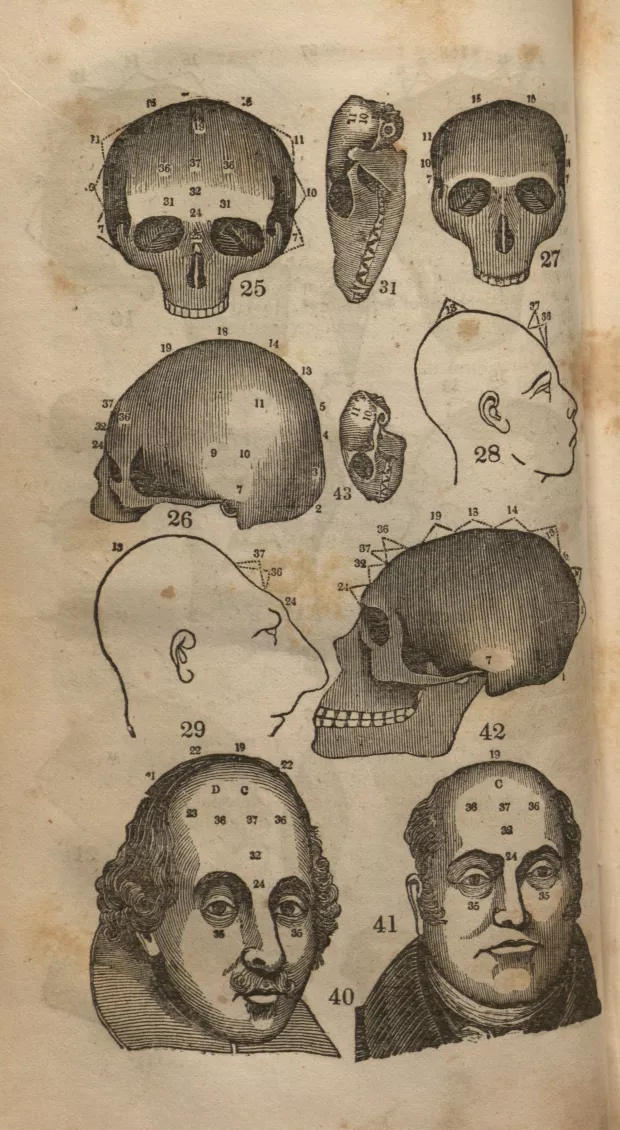Creation Date
1847
Height
15 cm
Width
8 cm
Medium
Genre
Description
This image provides multiple illustrations of skulls and famous busts, providing measurements for each by which organ size can be determined. Note especially the famous political figures, as well as the attention paid to notorious criminals.
The choice of heads displayed in Fowler’s Practical Phrenology (1847) is suggestive of the larger issues towards which phrenology was applied. Note especially the famous literary figures. The illustrations invite a comparison of humans to animals as well as a comparison of classes, ethnic groups, and levels of adherence to social norms.
The mapped head was associated with phrenology from its earliest publications throughout the nineteenth century. It provided a useful map of the locations on the skull discussed in phrenological tracts. One contemporary reviewer explained, “The author’s mode of treating the subject is illustrated, and rendered very intelligible, by a plate of the human head having the organs delineated” (“The Phrenological System"). The phrenological illustrations published by Fowler and Wells and others allowed untrained Americans to conduct their own phrenological readings. Similar illustrations were available to a British audience throughout the 1800s. Ultimately, phrenological guides such as these trained the nineteenth-century reader in a gaze which privileged the exterior and the scientific—a gaze Michel Foucault identified as the "clinical gaze" (Foucault 103ff). In this particular image, the choice of heads displayed is suggestive of the larger issues towards which phrenology was applied. The use of Shakespeare’s head as a model reflects a common interest in examining literary figures: Spurzheim owned and probably created a cast of Samuel Coleridge, made in 1825 (Paley 150); Charlotte Bronte was examined by a phrenologist in 1851 (Dames 367).
Associated Works
Copyright
Copyright 2009, Department of Special Collections, Memorial Library, University of Wisconsin-Madison, Madison, WI
Collection
Accession Number
BF 870.F6
Additional Information
Bibliography
"Advertisement 2 -- no Title." Christian Register and Boston Observer (1835-1843) May 13 1843: 76. ProQuest. Web. 1 May. 2009.
“Article VI.” American Phrenological Journal. (1841): 185-9. Print.
Colbert, Charles. A Measure of Perfection. Chapel Hill: U of North Carolina P, 1997. Print.
Combe, George. Outlines of Phrenology. 5th ed. London: Longman & Co., 1835. Print.
Dames, Nicholas. "The Clinical Novel: Phrenology and 'Villette.'" NOVEL: A Forum on Fiction29.3 (1996): 367-390. Print.
Foucault, Michel. The Birth of the Clinic. Trans. Alan Sheridan. New York: Routledge, 2003. Print.
Fowler, Orson Squire. Fowler’s Practical Phrenology: Giving a Concise Elementary View of Phrenology. New York: Fowler & Wells, 1847. Print.
“Further Particulars of Thurtell, &c.” Examiner 18 Jan. 1824: 40-41.
Paley, Morton D. Portraits of Coleridge. Oxford: Oxford UP, 1999. Print.
The Phrenological Journal and Miscellany Vol. 3. (August, 1825 – October, 1826): Edinburgh, 1826. Print.
“The Phrenological System.” The Bristol Mercury 1697 (September 30, 1822). Print.
Sekula, Allen. “The Body and the Archive.” October 39 (1986): 3-64. Print.
Spencer, Frank. History of Physical Anthropology. New York: Garland Pub., 1997. Print.
Wrobel, Arthur. "Whitman and the Phrenologists: The Divine Body and the Sensuous Soul." PMLA 89.1 (1974): 17-23. Print.

